
Hands on Review: 3 Stage Water Filter by Reverse Osmosis Revolution
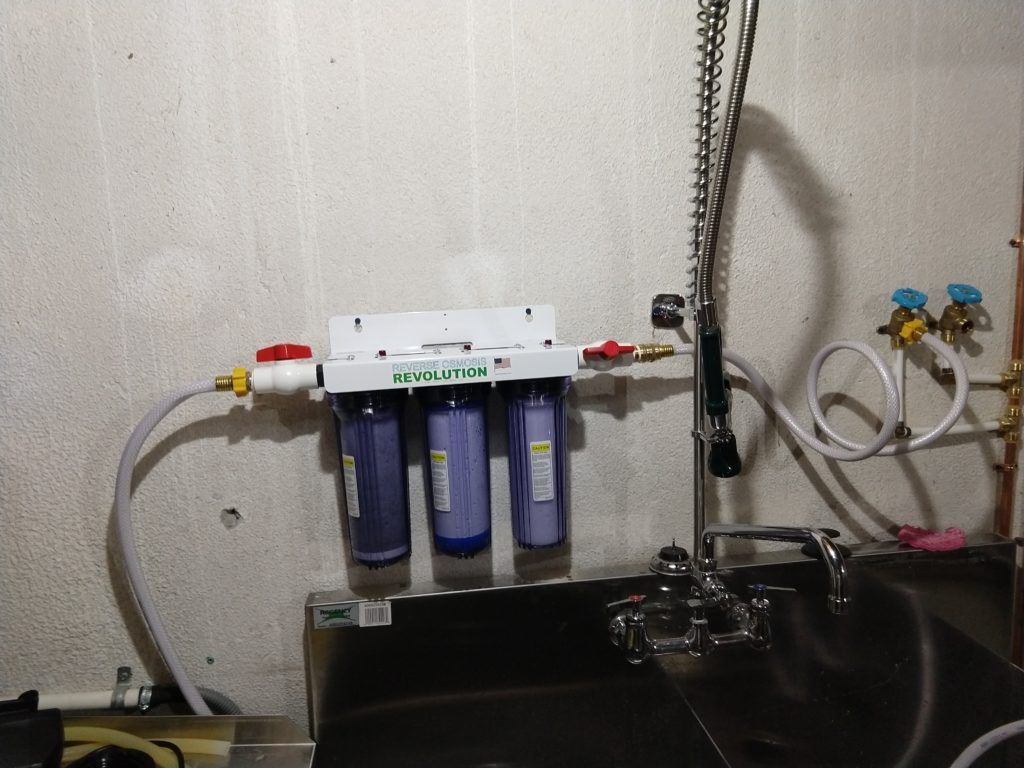
This review is by Homebrew Finds Contributor Brad Probert. Brad is an engineer, expert homebrewer and experienced reviewer. Grab a link to Brad’s website at the end of this review.
Reverse Osmosis 3-Stage Filter Review
You can take just about any aspect of your homebrew process and find someone to speak passionately about how “vitally important” that step is in the process of making your best beer. We all have our own personal filters (no pun intended) on which advice makes its way through the noise and leaves a lasting impression on us. For me, it’s been water. I’ve heard about the importance of brewing water from multiple sources. Even those doing blind taste tests on different brewing variables, or writing about shortcuts to your brewing process point to the importance of your water chemistry.
The bulk of my all-grain brewing experience has been using distilled water and adding brewing salts to get my desired water profile. I was satisfied with the end results of the beer, but I definitely was not satisfied with the task of buying 10 – 12 gallon jugs of distilled water from the grocery store (or more than one store because they were out). So I researched home water filtration options.
Get the Gear: Whole House 3-Stage Water Filtration System, 3/4″ port with 2 valves and extra 3 filters set affiliate link, note that multiple variations of this product may be available, as such a different version may appear at this link
I assumed reverse osmosis (RO) would be the filtration process of choice. However, I was shocked to find that the “standard” RO system created around 4 gallons of waste water for every gallon of RO water. Everyone told me, “water your house plants with it”. I don’t have houseplants. With kids, dogs, and a cat, I figure I’ve got enough things to take care of around the house without having to store water in buckets and find creative ways to use it. The idea of dumping 40 gallons of water down the drain to get 10 gallons of brewing water seemed ridiculous to me so I looked for other options. What’s more, the flow rate of the RO systems dictated you’d have to plan ahead to gather your brew water the day before over the span of several hours, and I really wasn’t interested in making my brew process longer.
Our city water has good taste and the water report says it doesn’t have any mineral content above the recommended levels for brewing. The main thing I wanted out of a water filter system was to avoid the occasional chlorine aroma I get.
I settled in on a 3-stage water filtration system from Reverse Osmosis Revolution. Although their name says Reverse Osmosis, this 3-stage filter system is not an RO system. The first stage has a 5 micron sediment filter to filter out things like dirt, dust, sand, etc. Being on city water, I don’t expect these type of contaminants, but it is still a good process step to help protect the downstream filter stages. The second stage is a granular activated carbon filter that’s targeted to remove chlorine and VOCs (volatile organic compounds) which can give you undesirable odors. The third stage is another carbon filter, this time a carbon block filter. It’s also designed to address odor-causing factors in your water, it just goes about it in a slightly different way.
The sediment filter has a life of 3 – 12 months, depending on the level of sediment in your water. The carbon filters both have a life of 6-12 months, at which point the carbon is expected to be used up from the chemical reactions of its carbon-fueled filtration process.
Hands on Review
The Reverse Osmosis Revolution 3-stage filter assembly came with a simple metal mounting bracket that I secured to the basement wall with 2 cement screws. The instructions pointed out the importance of keeping the 1st – 3rd stages in order, so I flipped the housing around since I needed the 1st stage to be on the right-hand side. The filter assembly comes with 3/4” threaded female ends on each end, and I easily bought fittings to go from 3/4” thread to garden hose fittings. Then, knowing that hoses can be a source of a lot of undesirable drinking water contaminants like lead and some plastics, I sought out some high quality drinking water hoses (CAMCO TastePURE) to connect to the filter inlet and outlet.
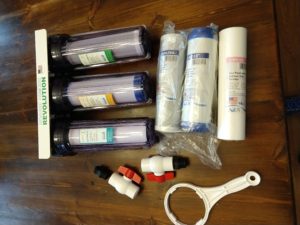 What came in my kit
What came in my kit
My initial runs of water through the filters had a grey tinge to the water that was readily apparent in my white brew bucket. There was also a detectable charcoal aroma. After consulting with the Reverse Osmosis Revolution team, they said that is typical with new filters, and to let the water run through for 10 minutes to flush any loose carbon free. They assured me that this was safe for consumption, but I knew I didn’t want to go research the effect of carbon particulate on beer brewing, so I let it run for 10 minutes before brewing with it and I found both the odor and color went away.
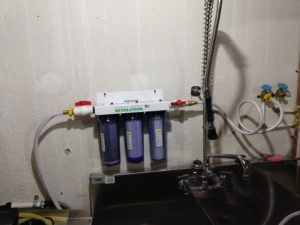 System mounted to the wall
System mounted to the wall
Conclusions
The water taste coming out of the filters was phenomenal. Our base city water is good (Detroit metro area in Michigan), and I have no complaints drinking unfiltered from the tap. But the water coming out of this filter made the taste and mouthfeel almost smoother, and made it very tasty. There’s a homebrewing anecdote out there that you shouldn’t make beer with water you don’t like the taste of. However, just because the water tastes good, doesn’t mean it’s good for brewing. So I tested the water both before and after the filter to quantify what was happening.
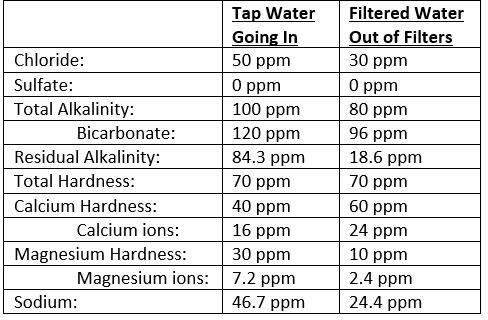 Water before and after – Hardness & Alkalinity measurements are in terms of CaCO3
Water before and after – Hardness & Alkalinity measurements are in terms of CaCO3
From the numbers above, you can see that my starting water wasn’t too high in any of the key minerals, but it was low in some. And it’s probably debatable if some of the before & after numbers really represent a change in the water or is just measurement variability. I do feel more confident knowing that the filters will help deal with variability in my source water. And I plan to add brewing salts based on my post-filter water data below. In the end, I’m happy with the water quality coming out of the system, and doubly happy to no longer be filling my Kroger shopping cart with jugs of water like I’m preparing for the apocalypse!
Get the Gear
Whole House 3-Stage Water Filtration System, 3/4″ port with 2 valves and extra 3 filters set affiliate link, note that multiple variations of this product may be available, as such a different version may appear at this link
Also Consider: Review: Portable Reverse Osmosis Water System
More Photos
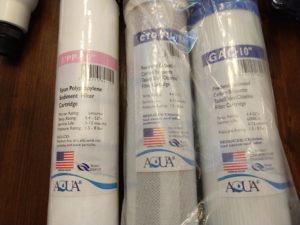 10″ Filter Cartridges
10″ Filter Cartridges
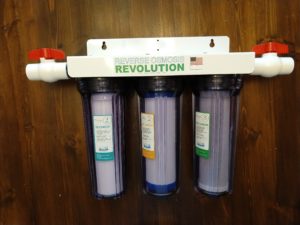 3 Stage Filter System
3 Stage Filter System
Special Thanks to Reverse Osmosis Revolution for providing the unit used for evaluation in this review.
By Brad Probert. Check out Brad’s website – beersnobby.com
pinnedThis post may contain affiliate links. We may make a commission when you use our links. This will never cost you extra. Thank you for supporting Homebrew Finds!
greatdealsreview:3stagefilterrev tag:tpr
On Amazon, they’re selling 6 sets of the three filter combo for $80. That’s 3-6 years depending on whether you change them at 6 month or 12 month interval.
I didn’t time myself, but I probably filled my 5 gallon bucket in about 1-2 minutes.
How long did it take for you to fill up like 20 gallons worth of water with this system? Im currently using an RO/DI system that was posted on the website a long time ago (maybe recently as well) and have liked it but agree on the waste water. I pump my water into a 28 gallon holding tank until im going to use it (max of 2 days) and yeah it wastes a ton of water and looking for a possible alternative to lower my water bill. Also, how much are the filter replacements if ya know?
What connector/adaptor was needed for attaching this filter to a garden hose fitting.